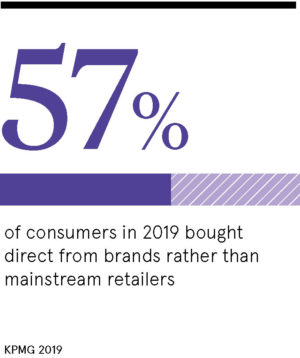While it caused reverberations across retailing, Nike’s move to pull its products from Amazon could be just the start of the shake-up.
Nike’s decision follows a two-year pilot, which saw the sportswear brand work with Amazon to reduce the sale of counterfeits on the site and increase those of its own products. But the results must have fallen short because, in November, Nike announced it would be forsaking the online retail giant to focus on selling directly to customers.
Analysts now believe other brands may follow suit, anticipating major growth in direct-to-consumer (D2C) sales globally. In the UK alone, Barclays Corporate Banking says 77 per cent of all manufacturers intend to invest in D2C in 2020 and this could mean more will be cutting ties with online marketplaces – though this is easier to do in stores than online. The trend for so-called immersive retail in bricks-and-mortar stores has seen brands such as Nordstrom offering spa services and art installations in its new seven-floor New York flagship and Lululemon installing workout studios and snack bars in its just-launched Mall of America concept store.
Advanced 3D modeling is proven to lead to higher sales conversions as well as reduced product returns
Meanwhile, Nike’s rival adidas has recently unveiled a flagship immersive retail space on London’s Oxford Street, packed with experiential retail features, including digital mirrors in fitting rooms that let shoppers see what they look like in a real-world scenario.
Physical retail vs digital retail
If Nike has turned its back on Amazon to improve the online shopping experience, what hopes does it have of replicating the type of immersive retail experience seen lately on the high street? It might want to look to brands like Levi’s, Tommy Hilfiger and Samsung, which have all partnered with experiential ecommerce platform Obsess to build virtual reality stores.
Neha Singh, founder and chief executive of Obsess, believes retailers need to go beyond the grid-of-thumbnails Amazon created to sell books 25 years ago. “A common consumer behaviour is ‘hedonic shopping’ where you enjoy the process of browsing for inspiration,” she says. “The consumer spend in that behaviour actually ends up being greater, but this primarily happens offline today. We are bringing that same consumer behaviour to online shopping.”
Of course, ease of discovery isn’t the only reason people like shopping in real life. As tactile beings, we also like to see how products fit and feel. Meeting this need digitally is a major challenge, but one way retailers are trying is with advanced 3D modelling that, thanks to virtual reality, enables shoppers to visualise how products would look in their homes.
“This is proven to lead to higher sales conversions as well as reduced product returns, which are a huge operational expense for brands and retailers,” says Dalia Lasaite, co-founder and chief executive
of CGTrader.
The D2C brands winning at immersive retail
As exciting as these solutions may be, providing immersive retail experiences on your website or app doesn’t necessarily mean you’ll succeed as a D2C brand. Nailing social media is just as important, if not more so.
“The connection between blogs, vlogs, YouTube channels, product pages, Instagram posts and in-store touchpoints is crucial,” says Benoit Soucaret, creative director of experience design at LiveArea. “Savvy brands are integrating and aligning social and customer journeys, so buyers have the complete picture. 
“In beauty, for instance, it’s no good having an influencer tutorial video trending online if consumers can’t easily find the product, check it suits their skin tone, complete the look with other products and buy easily on their mobile device. Website merchandising strategies should be aligned with other channels to make this journey as seamless as possible.”
Cosmetics brand Glossier is a D2C retailer that does this, developing new products from feedback in social comments, collaborating with influencers and deploying user-generated content pulled from its social channels.
“The site’s reviews system helps users find reviews that are most relevant to them, filtering by age, skin type and gender for each product,” says Mr Soucaret. “And discounted product bundles are available to trial various products and looks. The simplicity and customer-focused ethos of the brand is coherent throughout all stages of the customer journey.”
Another example of D2C done well is Dollar Shave Club, which has built a billion-dollar empire by offering a better grooming experience at a more affordable price. Dollar Shave Club also demonstrates the power of the subscription model, something that Nike is experimenting with through its Nike Adventure Club for kids.
So long, Amazon
When Nike announced its split from Amazon, it said it wanted to “focus on elevating consumer experiences through more direct, personal relationships”. One way it’s already successfully doing this is through its NikePlus programme, which boasts 185 million members.
Members can unlock all sorts of benefits by using Nike’s app in-store, like the ability to request shoes to try on and checkout without queueing. But they can also enjoy perks at home, for example, by using it to measure their shoe size through their smartphone’s camera. Nike says it aims to make stores “an extension of the mobile experience” by tightening the relationship between the channels.
While it all adds up to a great retail experience, it doesn’t come cheap; Nike invested $1 billion in immersive retail capabilities and concepts during the fiscal year 2019. It’s clear that any consumer brands walking away from Amazon to focus on a customer-first business model will need deep pockets.
Physical retail vs digital retail
The D2C brands winning at immersive retail

